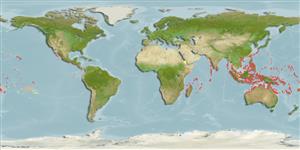>
Ovalentaria/misc (Various families in series Ovalentaria) >
Pomacentridae (Damselfishes) > Pomacentrinae
Etymology: Pomacentrus: Greek, poma, -atos = cover, operculum + Greek, kentron = sting (Ref. 45335).
More on authors: Evermann & Seale.
Issue
There are several species involved in the Pomacentrus philippinus complex that information (and references) for this species (and other species involved) will be checked, verified and updated accordingly.
Environment: milieu / climate zone / Mức độ sâu / distribution range
Sinh thái học
Biển Cùng sống ở rạn san hô; không di cư; Mức độ sâu 1 - 20 m (Ref. 7247). Tropical; 30°N - 23°S
Indo-West Pacific: Western Australia to eastern Indonesia; north to the Ryukyus; including Taiwan, the Philippines, Malaysia, Brunei and East Timor.
Bộ gần gũi / Khối lượng (Trọng lượng) / Age
Chín muồi sinh dục: Lm ? range ? - ? cm
Max length : 10.0 cm FL con đực/không giới tính; (Ref. 5525)
Các tia vây lưng cứng (tổng cộng) : 13; Các vây lưng mềm (tổng cộng) : 13 - 15; Tia cứng vây hậu môn: 2; Tia mềm vây hậu môn: 13 - 15; Động vật có xương sống: 26. This species is distinguished by the following characters: D XIII,13-15 (usually 14); A II,13-15 (usually 14); pectoral rays 16-18 (rarely 16); tubed lateral-line scales 16-19 (usually 17-18); total gill rakers on first arch 21-24 (usually 22-23); body depth 1.9-2.2 (mean 2.1) in SL; preorbital
usually with patch of scales, occasionally naked or with just a few isolated scales; suborbital
with single row of scales, occasionally restricted to posterior part, continuing around posterior
margin of the eye. Colouration: in life, usually charcoal to greyish with broad black scale margins on side of body, forming a network, sometimes a slight to strong yellow hue on caudal peduncle and lower sides; dorsal and anal fins are charcoal or blackish with posterior margin broadly orange (sometimes greatly reduced on anal fin); caudal fin is orange; pectoral fins with a black spot covering base, invading axil of fin; body side of pectoral-fin axil is distinctly orange; occasionally overall blackish to dark brown, including median fins except sometimes slightly orange on posteriormost portion of caudal fin; juveniles (< about 3.0 cm SL) mainly bluish grey with caudal fin, caudal peduncle, and adjacent portions of dorsal and anal fins bright yellow; Rowley Shoals, Western Australia population have very dark overall with orange portions of dorsal and caudal fins replaced with bright yellow and usually with entirely black anal fin (Ref. 131255).
Body shape (shape guide): fusiform / normal; Cross section: compressed.
Adults occur in lagoons, steep-sided channels, and seaward reefs from 2 to over 12 m (Ref. 1602). Usually found in groups off the sides of vertical drop-offs and overhanging ledges (Ref. 1602). Oviparous, distinct pairing during breeding (Ref. 205). Eggs are demersal and adhere to the substrate (Ref. 205). Males guard and aerate the eggs (Ref. 205). Diurnal species (Ref. 54980; 113699). Maximum depth reported taken from Ref. 128797.
Life cycle and mating behavior
Chín muồi sinh dục | Sự tái sinh sản | Đẻ trứng | Các trứng | Sự sinh sản | Ấu trùng
Oviparous, distinct pairing during breeding (Ref. 205). Eggs are demersal and adhere to the substrate (Ref. 205). Males guard and aerate the eggs (Ref. 205).
Allen, G.R., M.V. Erdmann and P.D. Pertiwi, 2017. Descriptions of four new species of damselfishes (Pomacentridae) in the Pomacentrus philippinus complex from the tropical western Pacific Ocean. J. Ocean Sci. Found. 25:47-76. (Ref. 114927)
IUCN Red List Status (Ref. 130435: Version 2025-1)
Threat to humans
Harmless
Human uses
Các nghề cá: Tính thương mại; Bể nuôi cá: Tính thương mại
Các công cụ
Special reports
Download XML
Các nguồn internet
Estimates based on models
Preferred temperature (Tài liệu tham khảo
123201): 25.3 - 29.3, mean 28.4 °C (based on 2636 cells).
Phylogenetic diversity index (Tài liệu tham khảo
82804): PD
50 = 0.5000 [Uniqueness, from 0.5 = low to 2.0 = high].
Bayesian length-weight: a=0.01778 (0.00993 - 0.03183), b=2.98 (2.82 - 3.14), in cm total length, based on LWR estimates for this species & (Sub)family-body (Ref.
93245).
Mức dinh dưỡng (Tài liệu tham khảo
69278): 2.7 ±0.29 se; based on food items.
Thích nghi nhanh (Tài liệu tham khảo
120179): Chiêù cao, thời gian nhân đôi của chủng quần tối thiểu là dưới 15 tháng (Preliminary K or Fecundity.).
Fishing Vulnerability (Ref.
59153): Low vulnerability (10 of 100).
🛈
Nutrients (Ref.
124155): Calcium = 126 [70, 212] mg/100g; Iron = 0.834 [0.517, 1.318] mg/100g; Protein = 18.6 [17.6, 19.6] %; Omega3 = 0.138 [0.086, 0.220] g/100g; Selenium = 18.8 [10.9, 33.9] μg/100g; VitaminA = 144 [49, 433] μg/100g; Zinc = 2.2 [1.5, 3.0] mg/100g (wet weight);
